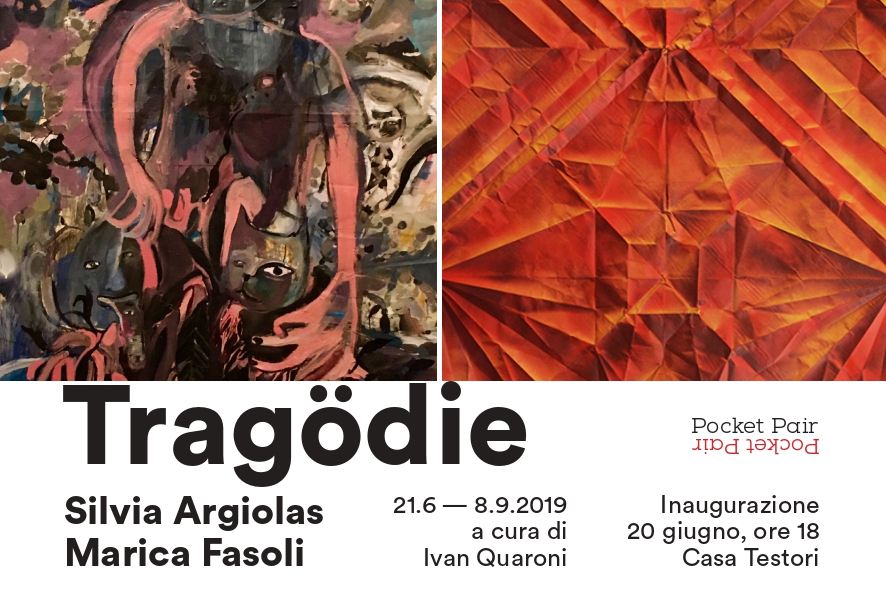TRAGÖDIE
Marica Fasoli and Silvia Argiolas
Curated by Ivan Quaroni
Casa Testori
21 June – 8 September 2019

TRAGÖDIE. INTRODUCTION
Ivan Quaroni
The linguistic barbarities of present-day communication – some would say mass media communication – have subjected philosophy to numerous freeze-drying processes for public use and consumption. Among the concepts this type of pulp journalism has consigned to the mediocrity of everyday language, are two extremely significant substantivized adjectives: Dionysian and Apollonian.
These terms are used crudely today to describe two aspects or attitudes of human conduct. The former, of an orgiastic nature, refers to feelings of exaltation and a tumult of the instinctive and irrational sphere. The latter, sunnier in outlook, evokes ideas of order and harmony proper to logical and rational thought. They derive from two ancient Greek divinities. Dionysus was the ancient god of vegetation, the incarnation of the vital lymph, hybrid and multiform, that nourishes mystic and sensual explosions, according to a principle of the indistinguishability, or primary communion, between man and nature. Apollo was the divinity of cumulative qualities, the cheerful charioteer, the protector of shepherds and flocks, the patron of music, poetry, medicine and divination, acute of judgment, obscure in his prophecies.
Dionysian and Apollonian took shape in the mind of a young German philologist buried in a corner of the Alps during the 1870-71 Franco-Prussian war, “While the thunder of the battle of Worth rolled over Europe”. Friedrich Nietzsche published his first work, The Birth of Tragedy from the Spirit of Music, or Hellenism and Pessimism, in 1872, leading off with an amazing incipit: “We shall have gained much for the science of aesthetics, when once we have perceived not only by logical inference, but by the immediate certainty of intuition, that the continuous development of art is bound up with the duplexity of the Apollonian and the Dionysian”.
It was, he maintained, the combination of the two principles originating in the opposing origins and aims of these two divinities, always in open contrast and “reciprocal excitation”, that ultimately produced works of art, initially in the particular form of the Greek tragedy. Fourteen years after publishing this work, however, in Attempt at Self-Criticism (1886), Nietzsche applied these primary and visionary intuitions extensively to art as a whole, suggesting that from this – and not from morality – derived man’s true metaphysical activity.
The Birth of Tragedy grafts, almost like a form of overtyping, with Arthur Schopenhauer’s pessimistic concept The World as Will and Representation (1818). The Dionysian is here seen as a form of total identification with original grief, as a state that enters when the principle of individuation is broken. It thereby produces a mystic, erotic conjunction with nature, an ecstatic trance that the author of Tragedy compares with the inebriation produced by narcotic drinks or by the “mighty approach of spring”.
Where Schopenhauer remarked on the unspeakable horror that seizes man when he loses faith in the forms of his awareness of appearances, Nietzsche foresaw the possibility of reconciliation with nature. It is here that the distance between Nietzsche’s and Schopenhauer’s thought becomes evident. Nietzsche wonders, in fact, whether pessimism – that is to say the conscious- ness that the world and life cannot give any real satisfaction, any permanent joy – is necessarily a sign of decline, of decadence, or whether there may exist a pessimism of strength, “An intellectual predilection for what is hard, awful, evil, problematical in existence, owing to well-being, to exuberant health, to fullness of existence”.
TRAGÖDIE. TWO APPARENTLY EXEMPLARY PFOOF
Ivan Quaroni
The premises quoted above could now provide a key an interpretation of the artistic quests of Silvia Argiolasand Marica Fasoli. We could, that is to say, apply the categories contained in Nietzsche’s first work to arrive at an in-depth penetration of their different expressive outlooks.
Argiolas’s painting is dominated by the Dionysian spirit, by an attraction towards the Titanic and barbaric, by a concern for the painful base of existence and for its Panic and sensual counterpart. Her visual statements express a courageous outlook, intent on examining the moment of madness, the erotic swoonings, the ecstasies and agonies of the experiential magma, but also the trivial ordinariness of extraordinary or marginal existences.
Marica Fasoli’s outlook, on the other hand, is placid and distilled, governed by the golden, dreamlike geometry of the Apollonian. Her pictorial quest decants the world into abstract forms, filtering it through a plethora of diagrams that symbolize phenomenic reality, without ever representing it directly. The mimetic impetus, which has always been the stylistic trademark of her work, is addressed towards the skin of the image, which is at the same time a structural and a conceptual surface. Argiolas’s is a painting unleashed by a watchful abandonment, which takes and gives, as a sort of poetic document, the collision with vital experience. Fasoli’s is a distilled and meditated painting, which observes life from a remote viewpoint in order to extract an ulterior sense from it, x-raying the structure so as to transmit it to the observer in forms that are Platonic and ideal, yet possessed of a powerful seductive capacity.
Tragödie is part of Pocket Pair, a cycle of exhibitions coordinated by Marta Cereda and launched by Casa Testori in 2018. The title of the cycle takes up an expression from poker that indicates the situation in which a player has two cards, of equal value, and must bet on them. In the same way, the curators are betting on emerging talents, two artists of equal value, to give life to a high quality two-person exhibition, set up on the ground floor of Casa Testori where they are free to meet, even within the individual rooms, to visit each other, to dialogue closely.
Posted on: 12 November 2021, by : Alessandro Ulleri



















